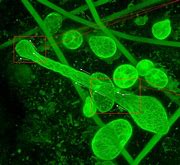Microtubules, those tiny structures within our cells, play a crucial role in providing support and facilitating essential cellular functions like cell division. These microscopic filaments are constantly in flux, assembling and disassembling by adding or removing tubulin building blocks at their ends. The intricate dynamics governing whether a microtubule elongates or shortens have long baffled scientists due to the complexity and minuscule nature of these structures.
In a groundbreaking discovery, a team of researchers has made significant strides in unraveling this mystery. Through a blend of cutting-edge computer simulations and innovative imaging techniques, they have unearthed a pivotal insight: the key factor influencing a microtubule’s growth lies in the ability of tubulin proteins at its ends to connect sideways. Dr Vladimir Volkov from Queen Mary University of London emphasized the importance of this revelation, stating,
“Understanding how microtubules grow and shorten is crucial as it underpins vital cellular processes like division and motility.”
The collaborative nature of this research effort underscores the value of interdisciplinary approaches in scientific exploration. Dr Maxim Igaev from the University of Dundee highlighted how merging physics with biology offered a fresh perspective on this biological conundrum. He noted,
“By bridging these disciplines, we’ve been able to tackle this complex question from a new angle. This fusion not only enriches both fields but also sets the stage for discoveries that would be unattainable through isolated efforts.”
This study serves as a testament to the power of interdisciplinary collaboration in advancing our knowledge of fundamental biological mechanisms. By delving into the physical principles that govern cellular structures such as microtubules, researchers can not only enhance their understanding but also drive innovation at the intersection of biology and physics.
Beyond its academic implications, this research carries significant potential for biomedical applications. Insights gained from deciphering microtubule growth could fuel advancements in areas related to cell proliferation and disease treatments, particularly in oncology where understanding cellular dynamics is paramount.
The journey towards unlocking the secrets of microtubule growth showcases how diverse perspectives coming together can shed light on age-old mysteries while paving the way for transformative discoveries at the crossroads of science.









Leave feedback about this